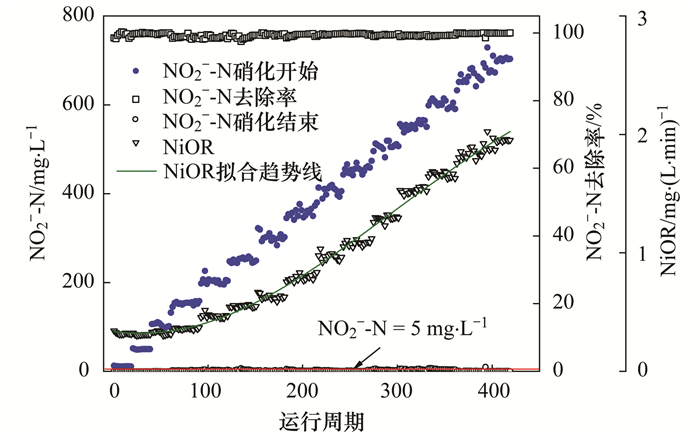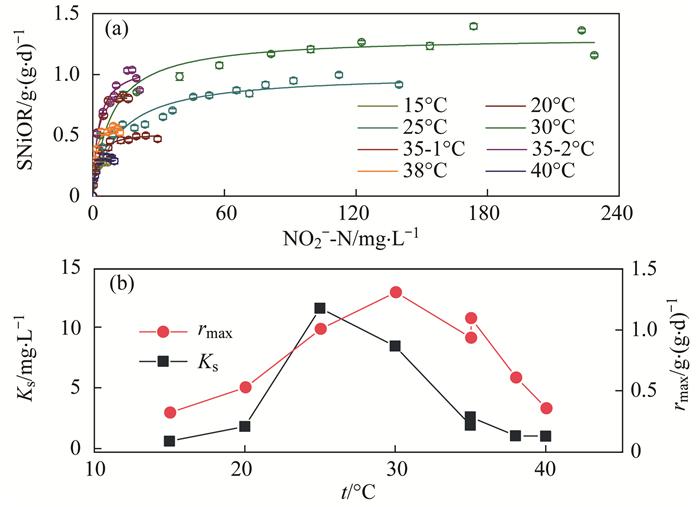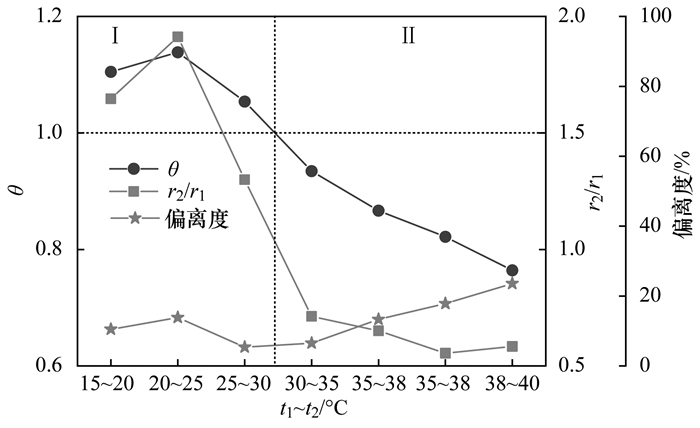2. 甘肃省污水处理行业技术中心, 兰州 730070;
3. 甘肃省轻工研究院, 兰州 730070;
4. 北京城市排水集团有限责任公司科技研发中心, 北京 100044
2. Sewage Treatment Industry Technical Center of Gansu Province, Lanzhou 730070, China;
3. Gansu Province Light Industry Research Institute, Lanzhou 730070, China;
4. Research and Development Center of Beijing Drainage Group Co., Ltd., Beijing 100044, China
生物脱氮系统中, 氨氧化菌(ammonia-oxidizing bacteria, AOB)和亚硝酸盐氧化菌(nitrite-oxidizing bacteria, NOB)以协同作用共存, 实现氨氮(NH4+-N)向硝态氮(NO3--N)转化, AOB将NH4+-N氧化为亚硝态氮(NO2--N), NOB将NO2--N进一步氧化为NO3--N.其中NOB主要是由四类菌属构成:硝化杆菌属(Nitrobacter)、硝化球菌属(Nitrococuus)、硝化刺菌属(Nitrospina)和硝化螺菌门(Nitrospira)[1].有研究表明, Nitrobacter和Nitrospira是污水处理系统中最为常见的NOB菌属[2], 在高底物浓度、高溶解氧条件下Nitrobacter含量远高于Nitrospira[3, 4].
目前, 现有研究大多集中于氨氧化过程的控制因素[5, 6], 较少研究集中于环境因素对亚硝酸盐氧化过程的影响.由于Nitrobacter菌群生长缓慢、对环境因子的变化比较敏感, 所以目前大多污水处理厂面临硝化不完全这一困境, 且污水处理厂污泥中NOB占细菌总数比例一般低于5%, 采用此类污泥研究NOB的性质容易影响试验结果的可靠性和稳定性[7].此外, 温度变化会导致细菌的生理学变化, 比如细胞膜流动性降低、细菌中酶的活性也存在适应性问题等[8, 9].而目前鲜有文献报道温度变化对Nitrobacter菌群活性的影响.此外, 微生物生化反应动力学的研究已日渐成熟, 提出了许多微生物受单一因素影响的抑制动力学模型[10~16].在研究某种因素对微生物影响时结合动力学模型, 并对其进行统计学分析已成为国内外研究热点[17~22].生化反应动力学能够最直接地体现基质浓度和降解速率的变化关系, 进而描述微生物活性.因此, 本试验在实现Nitrobacter富集基础上, 基于Monod模型考察系统温度对Nitrobacter活性动力学影响, 进而采用菲尔普斯方程, 获得温度变化对Nitrobacter活性影响程度, 指导生物脱氮技术在理论研究及实际工程中的应用.
1 材料与方法 1.1 试验用水、接种污泥及水质分析项目本试验用水采用人工模拟废水, 其水质特性为:原水采用去离子水, 进水NO2--N通过投加NaNO2溶液实现, 初始pH通过1mol·L-1盐酸(HCl)溶液和1 mol·L-1氢氧化钠(NaOH)溶液调节.其他成分如下:0.4 g NaHCO3, 0.9 g KH2PO4, 1.2 g K2HPO4, 0.9mL微量元素, 每升微量元素中含有:1.25 g EDTA、0.55 g ZnSO4·7H2O、0.4 g CoCl2·6H2O、1.275 g MnCl2·4H2O、0.4 g CuSO4·4H2O、0.05 g Na2MoO4·2H2O、1.375 g CaCl2·2H2O、1.25 g FeCl3·6H2O和44.4 g MgSO4·7H2O.此外, 硝化过程中溶解氧(DO)控制在4~4.5 mg·L-1, 采用加热棒控制反应器内混合液的温度.
本试验接种污泥取自兰州市西固区兰炼污水处理厂氧化沟好氧段污泥, 具有良好生物脱氮性能, 初始混合液挥发性悬浮固体浓度(MLVSS)为3 323 mg·L-1.
NO2--N、NO3--N、混合液悬浮固体浓度(MLSS)及MLVSS均采用国家标准方法测定[22]; pH值、DO和温度通过WTW-Multi3420实时监测; 宏基因组物种注释和丰度分析:①污泥样品的Scaffolds/Scaftigs序列与NCBI-NT数据库中的细菌、古菌、真菌和病毒序列进行BLASTN比对(E值设定为 < 0.001). ②通过MEGAN[23]软件采取“最低共同祖先”算法[24], 将参考序列不同物种分枝前的最后一级共同分类作为目标序列的物种分类注释信息. ③结合Saffolds/Scaftigs序列在各样本中的丰度数据, 获得各样本在各个分类等级上的相对丰度分布.
1.2 Nitrobacter富集装置及运行方式采用有效容积为7 L的SBR装置富集Nitrobacte, 控制装置内混合液温度为(25±1)℃, pH为7.7~8.1, DO控制在4.0 mg·L-1, 在线监测DO值实时控制硝化终点.通过梯度提高NO2--N浓度对接种污泥进行驯化, 经过419个周期, 可处理进水NO2--N浓度为700 mg·L-1的人工模拟废水, 驯化后污泥MLVSS=(1485±35)mg·L-1, 具体运行条件见表 1.
|
|
表 1 NOB富集过程运行条件 Table 1 Operational parameters of the enrichment AOB |
1.3 温度对Nitrobacter活性影响批次试验
本试验采用有效容积为3 L的SBR反应器(高50 cm, 内径15 cm).运行方式:瞬时进水(1 min), 硝化(通过在线监测DO值实时控制硝化终点), 静置沉淀(30 min), 排水(5 min).
批次试验以富含Nitrobacter的活性污泥为研究对象, 控制恒定pH(7.5±0.1)、DO浓度(4.0~4.5 mg·L-1)条件下, 通过设定不同NO2--N浓度, 基于批次试验考察不同温度对Nitrobacter活性及其Monod方程动力学参数的影响.
2 结果与讨论 2.1 Nitrobacter的富集培养及群落结构分析图 1为Nitrobacter富集阶段SBR系统硝化开始、结束时NO2--N浓度、亚硝态氮氧化速率(NiOR)以及NO2--N去除率的变化规律.试验运行过程中, 进水NO2--N浓度从10 mg·L-1梯度升高到700 mg·L-1.可以看出, 硝化结束时NO2--N浓度均低于5 mg·L-1, 平均值为2.07 mg·L-1, 整个试验周期NO2--N去除率均达到98%以上, 系统具有良好的脱氮性能.此外, 由于进水NO2--N浓度的增加, NiOR也逐渐增加[0.32 mg·(L·min)-1→1.93 mg·(L·min)-1], 二者呈正相关.当NO2--N≥700 mg·L-1时, NiOR始终维持在1.80 mg·(L·min)-1以上, 表明SBR系统具有良好的亚硝酸盐氧化性能.

|
图 1 Nitrobacter富集培养阶段SBR系统硝化性能 Fig. 1 Nitrification performance of the SBR system during Nitrobacter enrichment |
对微生物16S rRNA基因的特定区域进行靶向测序(Targeted sequencing), 获得SBR系统内微生物群落的具体组成结构(图 2).通过Origin 9.0软件, 对各样本中的优势物种(取总体丰度前30位物种)在属水平上分析并绘制柱状图.分析发现:各平行样在属水平上微生物类型基本相同, 其中Nitrobacter平均相对丰度为40.3%.此外, 基因测序结果显示其余菌属在污泥微生物群落中占比均低于5%, 表明经过富集培养后SBR系统污泥微生物中Nitrobacter占绝对优势地位.

|
图 2 SBR系统微生物群落组成结构 Fig. 2 Microbial community composition in the SBR system |
图 3为不同温度条件下硝化反应开始、结束时NO2--N浓度, 比亚硝态氮氧化速率(SNiOR)变化规律.本试验共运行246个周期, 分为3个阶段.阶段Ⅰ(第1~56周期):梯度增加温度(15℃→20℃→25℃→30℃→35℃), 硝化反应开始NO2--N浓度与SNiOR呈现出相同的变化趋势.其中, 当温度分别为15、20、25和30℃时, 随着硝化开始NO2--N浓度增加, SNiOR均呈增加趋势, 当t=30℃时, rmax(最大SNiOR)达到最大(以N/VSS计), 为1.40 g·(g·d)-1.当温度增加到35℃时, 相比于30℃条件下rmax出现明显下降趋势, 为0.82 g·(g·d)-1.阶段Ⅱ(第57~217周期):Nitrobacter活性恢复阶段, 为进一步验证30℃→35℃时Nitrobacter活性降低这一现象, 本试验在25℃条件下进行了160个周期的Nitrobacter活性恢复, 恢复后硝化反应开始NO2--N=60.0 mg·L-1时, SNiOR=0.97 g·(g·d)-1, 达到Nitrobacter活性降低前水平.阶段Ⅲ(第218~246周期):梯度增加温度(35℃→38℃→40℃), rmax呈下降趋势[1.03 g·(g·d)-1→0.58 g·(g·d)-1→0.32 g·(g·d)-1].因此, 基于SNiOR表征Nitrobacter活性研究发现, 当温度介于15~30℃时, 随着温度的增加, Nitrobacter活性逐渐增加, 当温度介于30~40℃时, Nitrobacter活性随着温度的增加逐渐降低.

|
图 3 批次试验Nitrobacter氧化性能 Fig. 3 Batch test of Nitrobacter oxidation performance |
为了更好地描述不同温度条件对Nitrobacter菌属生长动力学影响, 采用Monod方程对试验数据进行非线性拟合, 分析拟合后动力学参数变化规律, 结果如图 4所示.从中可知, 在本试验浓度范围内, NO2--N浓度对SNiOR的影响均符合Monod方程[图 4(a)]. Ks为基质半饱和常数(以NO2--N计), 其物理意义为基质比降解速率达到最大比降解速率一半(rmax/2)时的底物浓度.由图 4(b)可知, 当温度介于15~25℃之间时, Ks随温度升高而增大, 当温度介于25~40℃时, Ks随温度升高而降低.拟合结果显示, 30℃条件下rmax达到最大, 为1.31 g·(g·d)-1, 表明在该温度条件下Nitrobacter活性最好.此外, 40℃条件下Nitrobacter活性仅为30℃条件下的27%.

|
35-1℃是活性恢复前试验,35-2℃是恢复后35℃条件下的试验 图 4 不同温度条件下, NO2--N对Nitrobacter活性动力学拟合 Fig. 4 Dynamics fitting of Nitrobacter activity to NO2--N under different temperature conditions |
Monod方程拟合后Nitrobacter动力学参数及其统计学分析结果见表 2.其中, 可决系数(R2)可表征试验数据与拟合曲线的接近程度, R2越大, 试验数据在拟合曲线附近越密集, 曲线拟合程度越高.拟合结果发现不同温度条件下方程可决系数(R2)均大于0.94, 拟合结果较好.统计学方差分析中F值与P值均能够预测自变量与因变量的关联程度. F值是回归方程的显著性检验, P值表示试验结果可信度, F值越大, P值越小, 可表明自变量和因变量显著相关, 方程拟合度越好, 且当P < 0.05时, 自变量可用于预测因变量.基于方差分析, 不同温度条件下F值较大, P值均较小, 且P值均小于0.001.综上可知, 基于统计学分析, Monod方程可较好的描述不同温度条件下底物浓度对Nitrobacter活性影响.
|
|
表 2 Monod方程拟合后动力学参数以及统计学分析 Table 2 Monod model fitting parameters and statistical analysis results |
2.4 不同温度对Nitrobacter活性影响程度
在污水处理中, 温度系数(θ)可以衡量系统温度对反应速率和净化能力的影响[25].可采用菲尔普斯方程r2=r1·θt2-t1计算系统不同温度区间内的θ值, 方程中r为不同温度(t)条件下基于Monod方程拟合后的最大比降解速率(rmax), θ值的大小可反映Nitrobacter对温度变化的敏感性, θ值偏离1的程度越大, 表明在该温度区间内温度变化对Nitrobacter活性影响越大.由图 5可知, 当SBR系统温度介于15~30℃之间时, θ值均大于1, rmax随着温度的增加而增加, 温度与Nitrobacter活性呈正相关(Ⅰ).而当系统温度介于30~40℃之间时, θ值均小于1, rmax随着温度的增加而降低, 温度与Nitrobacter活性呈负相关.采用θ值偏离1的程度(偏离度)衡量温度对Nitrobacter活性影响程度发现, 当温度介于25~35℃之间时偏离度较小, 表明在此温度范围内温度变化对Nitrobacter活性影响较小, 当系统温度小于25℃或大于35℃, 偏离度逐渐增加, 表明在此温度范围内温度变化对Nitrobacter活性影响较大.

|
图 5 不同温度区间内, 温度系数变化规律 Fig. 5 Variation of the temperature coefficient in different temperature ranges |
(1) 控制DO≥4 mg·L-1, t=25℃条件下, 以NaNO2为唯一能源, 通过梯度提高NO2--N浓度可实现Nitrobacter的富集, 经过419个周期, 宏基因组物种注释和丰度分析显示Nitrobacter占细菌总数40.3%, Nitrobacter成为优势菌种.
(2) 不同温度条件下Monod模型均较好地描述基质底物浓度对Nitrobacter活性的影响.拟合结果显示, 30℃条件下SNiOR达到最大, 为1.31 g·(g·d)-1, 表明在该温度条件下Nitrobacter活性最好.
(3) 基于菲尔普斯方程计算不同温度区间内θ值可知, 当系统温度低于25℃或高于30℃时, Nitrobacter活性随温度变化越敏感.
| [1] | Stackebrandt E, Goebel B M. Taxonomic note:a place for DNA-DNA reassociation and 16S rRNA sequence analysis in the present species definition in bacteriology[J]. International Journal of Systematic and Evolutionary Microbiology, 1994, 44(4): 846-849. DOI:10.1099/00207713-44-4-846 |
| [2] | Peng Y Z, Zhu G B. Biological nitrogen removal with nitrification and denitrification via nitrite pathway[J]. Applied Microbiology and Biotechnology, 2006, 73(1): 15-26. |
| [3] | Spieck E, Hartwig C, Cormack I, et al. Selective enrichment and molecular characterization of a previously uncultured Nitrospira-like bacterium from activated sludge[J]. Environmental Microbiology, 2006, 8: 405-415. DOI:10.1111/emi.2006.8.issue-3 |
| [4] |
包鹏, 王淑莹, 马斌, 等. 不同溶解氧间歇曝气对亚硝酸盐氧化菌的影响[J]. 中国环境科学, 2016, 36(9): 2696-2702. Bao P, Wang S Y, Ma B, et al. Effect of dissolve oxygen on the microbial community of the nitrite-oxidizing bacteria in an intermittent aeration reactor[J]. China Environmental Science, 2016, 36(9): 2696-2702. DOI:10.3969/j.issn.1000-6923.2016.09.024 |
| [5] |
孙洪伟, 尤永军, 赵华南, 等. 游离氨对硝化菌活性的抑制及可逆性影响[J]. 中国环境科学, 2015, 35(1): 95-100. Sun H W, You Y J, Zhao H N, et al. Inhibitory effect of free ammonia on the activity of nitrifying bacteria and recoverability[J]. China Environmental Science, 2015, 35(1): 95-100. |
| [6] | Gabarró J, Ganigué R, Gich F, et al. Effect of temperature on AOB activity of a partial nitritation SBR treating landfill leachate with extremely high nitrogen concentration[J]. Bioresource Technology, 2012, 126: 283-289. DOI:10.1016/j.biortech.2012.09.011 |
| [7] |
张宇坤, 王淑莹, 董怡君, 等. 游离氨和游离亚硝酸对亚硝态氮氧化菌活性的影响[J]. 中国环境科学, 2014, 34(5): 1242-1247. Zhang Y K, Wang S Y, Dong Y J, et al. Effect of FA and FNA on activity of nitrite-oxidising bacteria[J]. China Environmental Science, 2014, 34(5): 1242-1247. |
| [8] | Madigan M T, Martinko J M, Parker J. Brock biology of microorganisms[M]. Upper Saddle River, New Jersey: Prentice Hall, 2000. |
| [9] |
吴鹏, 陆爽君, 徐乐中, 等. 温度对ABR-MBR复合工艺处理生活污水的影响及其微生物群落分析[J]. 环境科学, 2014, 35(9): 3466-3472. Wu P, Lu S J, Xu L Z, et al. Effects of temperature on combined process of ABR and MBR for domestic sewage treatment and analysis of microbial community[J]. Environmental Science, 2014, 35(9): 3466-3472. |
| [10] | Goudar C T, Ganji S M, Pujar B G, et al. Substrate inhibition kinetics of phenol biodegradation[J]. Water Environmental Research, 2000, 72(1): 50-55. DOI:10.2175/106143000X137103 |
| [11] | Edwards V H. The influence of high substrate concentrations on microbial kinetics[J]. Biotechnology and Bioengineering, 1970, 12(5): 679-712. DOI:10.1002/(ISSN)1097-0290 |
| [12] | Andrews J F. A mathematical model for the continuous culture of microorganisms utilizing inhibitory substrates[J]. Biotechnology and Bioengineering, 1968, 10(6): 707-723. DOI:10.1002/(ISSN)1097-0290 |
| [13] | Haldane J B S. Enzymes[M]. London: Longmans Green and Co, 1930. |
| [14] | Aiba S, Shoda M, Nagatani M. Kinetics of product inhibition in alcohol fermentation[J]. Biotechnology and Bioengineering, 1968, 10(6): 845-864. DOI:10.1002/(ISSN)1097-0290 |
| [15] | Tessier G. Croissance des populations bactériennes et quantité d'aliment disponible[J]. Reviews Science, 1942, 80: 209-216. |
| [16] | Luong J H T. Generalization of Monod kinetics for analysis of growth data with substrate inhibition[J]. Biotechnology and Biochemistry, 1987, 29(2): 242-248. |
| [17] | Han K, Levenspiel O. Extended monod kinetics for substrate, product, and cell inhibition[J]. Biotechnology and Bioengineering, 1988, 32(4): 430-437. |
| [18] | Park S W, Bae W. Modeling kinetics of ammonium oxidation and nitrite oxidation under simultaneous inhibition by free ammonia and free nitrous acid[J]. Process Biochemistry, 2009, 44(6): 631-640. DOI:10.1016/j.procbio.2009.02.002 |
| [19] | Carrera J, Jubany I, Carvallo L, et al. Kinetic models for nitrification inhibition by ammonium and nitrite in a suspended and an immobilised biomass systems[J]. Process Biochemistry, 2004, 39(9): 1159-1165. DOI:10.1016/S0032-9592(03)00214-0 |
| [20] | Ciudad G, Werner A, Bornhardt C, et al. Differential kinetics of ammonia-and nitrite-oxidizing bacteria:A simple kinetic study based on oxygen affinity and proton release during nitrification[J]. Process Biochemistry, 2006, 41(8): 1764-1772. DOI:10.1016/j.procbio.2006.03.032 |
| [21] |
唐崇俭, 熊蕾, 王云燕, 等. 高效厌氧氨氧化颗粒污泥的动力学特性[J]. 环境科学, 2013, 34(9): 3544-3551. Tang C J, Xiong L, Wang Y Y, et al. Kinetic characteristics of high-rate ANAMMOX granules[J]. Environmental Science, 2013, 34(9): 3544-3551. |
| [22] | 国家环境保护总局. 水和废水监测分析方法[M]. (第三版). 北京: 中国环境科学出版社, 1997. |
| [23] | Huson D H, Mitra S, Ruscheweyh H J, et al. Integrative analysis of environmental sequences using MEGAN4[J]. Genome Research, 2011, 21(9): 1552-1560. DOI:10.1101/gr.120618.111 |
| [24] | Huson D H, Auch A F, Qi J, et al. MEGAN analysis of metagenomic data[J]. Genome Research, 2007, 17(3): 377-386. |
| [25] | 张自杰, 彭永臻. 对菲尔普斯(Phelps)公式、温度系数θ的实用价值与理论意义的探讨[J]. 哈尔滨建筑工程学院学报, 1983(2): 71-80. |
 2019, Vol. 40
2019, Vol. 40


